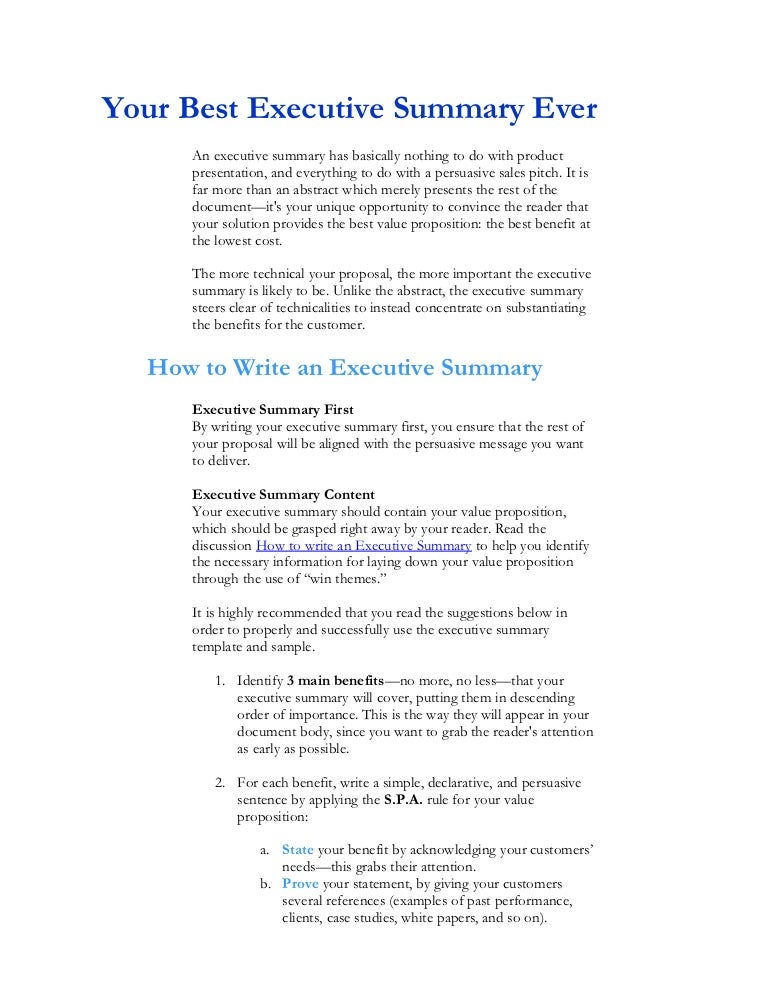Rfp Response Executive Summary Template

I have written, edited, or managed the creation of what feels like a gagillion business proposals in my career, and 90% of the time I had a feeling of dread throughout the whole process (this was obviously in the dark ages before Proposify existed). But nothing compared to the feeling of writing an executive summary. There is so much dissent about the function of the executive summary — what it should say, what it should do, how long it should be, and whether it be written before or after the body of the proposal — that it can add to the already stressful task of getting a winning proposal written, designed, and out the door to the client on time. It’s time to change all that. The executive summary is arguably the most valuable component of any proposal.
Its purpose is clear, its potential is huge, and putting it together can be straightforward if you change your approach and follow a few simple steps. I’ll share what I’ve learned about writing an effective executive summary for client proposals.
Henderson's relationship with the forum he created strained. A year after the split, and around five years after starting the site, he decided to take a break. So they split in two, with the disruptors known as the SIM team - on account of their focus on stringent accuracy - and the other team called ODB - representing the 'original database' style used by developers Sports Interactive. He saw division and bickering in the community, and grew frustrated with some of the behaviours and attitudes floating around. Cm 01 02 original database.
Executive Summary An executive summary that provides the respondent’s background, experience and other qualifications to provide tax counsel services. Background & Introduction Reinhart Boerner Van Deuren s.c. (Reinhart) was founded in 1894 in Milwaukee, and has been in.
To download XEX MENU 1.2, click on the Download button. You can then load XEX Menu xex menu 1.2 from the dashboard, giving you FTP access to the Jtag or RGH hacked Xbox 360. 
Hopefully, it will make the proposal process less painful, and help you convince anyone on your team who might disagree to follow your lead. Resistance is futile. The purpose of an executive summary First of all, the executive summary needs a rebrand.
To me, the name itself speaks of stuffy suits, boring, jargon-filled reports, and boardrooms filled with cigar smoke and people ready to say no. But that’s my hangup. They can’t wait to read your executive summary. In all seriousness, the word “summary” can be misleading, and this is the first mistake people often make when it comes to writing their executive summary. They think that this is where you explain the entire proposal in 250 words.
That you literally ‘summarize’ the proposal by rehashing everything from page one forward. But in fact, the purpose of the executive summary is to sell your solution to the client’s problem.
It should be persuasive, outlining why the client should choose your company. It should be specific and focus on results. The executive summary needs to be persuasive and highlight the benefits of your company/product/service, rather than being descriptive and focusing on the features. You can save the features for the body of the proposal. The executive summary needs to grab the reader’s attention and pique their interest. Even though you and your team spent painstaking hours writing this proposal, selecting just the right graphics, and coming up with the best solution for your client’s problem, they may only read this one page and then flip to your pricing table.
The executive summary helps the client decide quickly whether they're going to read the rest of the proposal, pass it on to other decision-makers, or if it's destined for the recycle bin. So you better make it good. When to write the executive summary This issue of whether you write the executive summary before or after the rest of the proposal is as divided as the issue of what’s better about a Reese’s Peanut Butter Cup, the chocolate or the peanut butter. Some people feel you should write the executive summary first because it can help you outline your concept and organize your thoughts for the entire proposal. That way it acts as a guide to members of your team who are tasked with preparing sections of the proposal, ensuring that everyone’s on the same page, that the big idea is consistent throughout, and that all necessary components are included. Others feel strongly that you should write the executive summary after you’ve prepared the rest of the proposal because then you’ve had a chance to work through the objectives and the solutions, and you’ll have a better idea of what you want to say and how you want to say it.
Plus things may have changed since you first started the proposal so you might need to adjust your approach. My suggestion is chocolate AND peanut butter. Election issue #147 I like to write the executive summary first because it helps to filter all the ideas our team had during the brainstorming process about the best way to pitch this client. With an executive summary written, or at least outlined, I’m more confident about delegating parts of the proposal creation process to different team members because they’ll understand the approach and what they need to do to contribute to a consistent, cohesive document. Once the body of the proposal is finished, I then go back to tweak the executive summary as needed. Sometimes new ideas rose to the top as we worked through the proposal, or early ideas turned out to be impossible to execute due to the client budget or timeline.